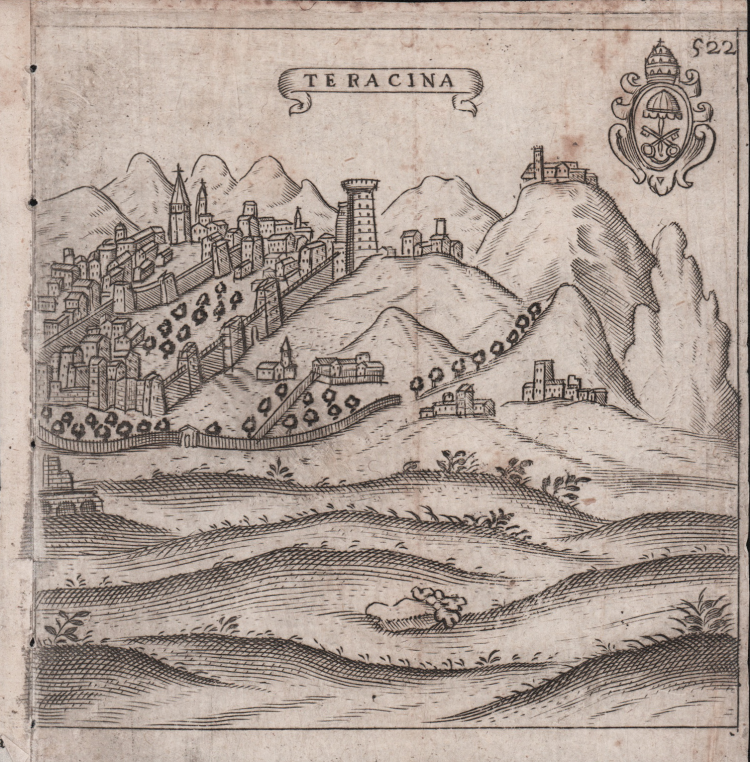



| Reference: | CO-703 |
| Author | Francesco SCOTO |
| Year: | 1665 |
| Zone: | Terracina |
| Printed: | Venice |
| Measures: | 120 x 120 mm |


| Reference: | CO-703 |
| Author | Francesco SCOTO |
| Year: | 1665 |
| Zone: | Terracina |
| Printed: | Venice |
| Measures: | 120 x 120 mm |
Plate taken from "Itinerario, overo nova descrittione de' viaggi principali d'Italia [...] di Francesco Scoto" published in Venice by Pietro Brigonci in 1665.
His first edition of the Itinerario was in 1665 and had the text taken from Cadorin's publication of 1659, which extended the story to Friuli, Sicily, Malta, Latium and the Holy Land, and in the same year a reprint also included plates on these territories.
In 1670, 1673, 1676 and 1679 there were other editions by Brigonci, all Venetian, all with the unchanged title "Itinerario, overo nova descrittione de' viaggi principali d'Italia [...] di Francesco Scoto", all enriched with just under forty antique prints with views of cities.
Franz Schott (1548-1622), Italianized as Francesco Scoto, was a native of Antwerp. A jurist and great traveler, brother of the better known Andreas, a Jesuit, philologist and antiquarian, he compiled "Itinerario overo decrittione de' viaggi principali in Italia." The work first appeared in Antwerp on the occasion of the Jubilee of 1600, under the title Itinerari Italiae rerumq[ue] romanarum libri tres, printed in the Officina Plantiniana by Joannes Moretus. Devoid of the iconographic apparatus, it was intended as a service to pilgrims traveling to Italy and an expression of a particular form of odeporic writing that embraced all those texts that take on the character of a travel guide and offer themselves as a tool aimed at orienting the traveler in his journey. It was a great success and was then published in numerous subsequent editions in Latin, Italian, French and English.
The Itinerary of Italy had its full development in the numerous Italian editions, which were richly illustrated with perspective views and city plans. The first illustrated Italian edition was edited by Pietro Bertelli and Francesco Bolzetta (Vicenza or Venice 1601); several editions by Bolzetta followed with an increasing number of cartographic illustrations. Schott's text was also used for their own editions of the Itinerario d'Italia by Matteo Cadorin (Padua 1654 and later) and Pietro Bigonci (Venice 1665).
Also in Rome, in the Jubilee year 1650, the publisher Filippo de Rossi printed Itinerario overo Nuova Descrittione de' Viaggi Principali d'Italia. There are 19 prints to which the map of Italy is added, and they are slightly more accurate.
The plates of the Roman edition (made by means of new copper plates) were reprinted in later editions - augmented - by the publishers Michelangelo and Pier Vincenzo de Rossi (1669, 1700 and 1717) and then in those edited by Fausto Amidei, a book dealer on the Corso, who had Antonio de Rossi print the first of his three editions of Francesco Scoto's Itinerario d'Italia in 1737. The others were in 1747 in the printing house of Bernabò and Lazzarini and in 1761 in the printing house of Generoso Salomoni.
Etching, usual editorial paper folds, in very good condition.
|
Franz Schott, Italianate as Francis Scot, was a native of Antwerp. Jurist and a great traveler, brother of the famous Andreas, a Jesuit philologist and antiquarian, wrote "Itinerario overo decrittione de' viaggi principali in Italia". The work appeared for the first time, written in Latin, in Antwerp in 1600 (Itinerarium Italiae), on the occasion of the Jubilee, to be used by pilgrims on their way to Italy. The work was subsequently published in numerous editions in Latin, Italian, French and English. The Itinerary of Italy Schott is the expression of a particular form of travel writing that, in the multiplicity and diversity of its manifestations, embraces all those texts that take on the character guide for the trip and offer as a tool aimed at guiding the traveler in its path.
|
|
Franz Schott, Italianate as Francis Scot, was a native of Antwerp. Jurist and a great traveler, brother of the famous Andreas, a Jesuit philologist and antiquarian, wrote "Itinerario overo decrittione de' viaggi principali in Italia". The work appeared for the first time, written in Latin, in Antwerp in 1600 (Itinerarium Italiae), on the occasion of the Jubilee, to be used by pilgrims on their way to Italy. The work was subsequently published in numerous editions in Latin, Italian, French and English. The Itinerary of Italy Schott is the expression of a particular form of travel writing that, in the multiplicity and diversity of its manifestations, embraces all those texts that take on the character guide for the trip and offer as a tool aimed at guiding the traveler in its path.
|